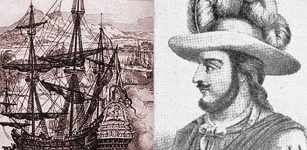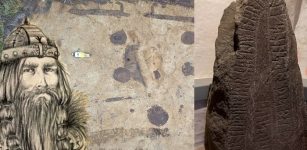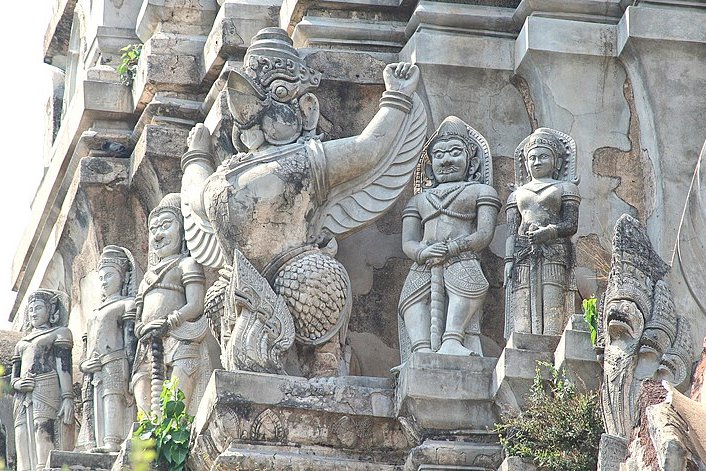Sacred Bird Garuda And Stealing Of Amrita Drink Of Immortality From The Gods
A. Sutherland - AncientPages.com - The holy bird Garuda is one of the most interesting figures in the Hindu pantheon. Garuda (not a god himself) is half-man, half-bird, and the enemy of the serpents (Nagas).
Garuda sculpture. Wat Ratchaburana, Ayutthaya, Kingdom of Thailand. Image source
He symbolizes courage and represents the utterances of the sacred teachings or Vedas, and those who read them are transported upon the wings of wisdom and with the power of lightning.
It is believed that Garuda's wings chant the Vedas as he flies around the heavens.
Similar mythological creatures can be found in the beliefs of other nations. A Babylonian/Sumerian myth says about this gigantic creature (the messenger of the gods), half man and half bird with a giant lion-head that could walk on two legs like a human and was known as Anzu/Zu (‘the wise one’).
According to Slavic folklore, the Firebird was a creature with eyes that sparkled like crystal and golden feathers that shone as bright as the sun. Roman, Greek or Egyptian mythologies speak about a mythical firebird, Phoenix, a symbol of Sun, immortality, rebirth, resurrection, and eternal life. This mythical creature has its counterpart in China, Japan.
Birth of Garuda And His Importance In Hinduism And Buddhism
According to the Mahabharata, India's great epic, Garuda was born from an egg and appeared as a powerful extremely brilliant light compared to the gigantic cosmic catastrophe that annihilates the entire world at the end of every age.
Frightened by Garuda's unlimited power, the Devas begged him to reduce himself in size and energy, and Garuda immediately complied with their request. Legend has it, Garuda was so huge that everyone mistook him for the god of fire, Agni.
Most frequently, Garuda is depicted as a humanoid creature with golden wings, clawed paws, and holding a snake in its beak. According to Hindu and Buddhist mythology, the movement of his wings gave rise to a storm; the brilliance of his feathers was so strong that it overshadowed even the glow of the sun. Garuda's wings were so huge that they could span several miles and the flapping of his wings was enough to create hurricane-like winds, which darkened the skies and destroyed houses.
He had the ability to increase his strength as much as he needed.
Garuda pillar, Nepal. Image credit: Arnsh locus - CC BY-SA 4.0
Captivity Of Garuda’s Mother
Garuda was born to the sage Kashyapa and the mother of birds, Vinata. Kashyapa was also married to Vinata's sister Kadru, who gave birth to a thousand snakes (ancestors of all the snakes that live on earth today). One day, Vinata and Kadru, entered into a trivial bet regarding the color of the tail of Uchchaihshravas, the divine, seven-headed flying horse, who emerged during the Churning of the Ocean of Milk. Kadru claimed the horse's tail was black while Vinata was convinced it was white.
As a result of Kadru's cheating, Vinata lost the bet and became Kadru's slave, who was treated very badly by her and her serpent sons.
Stealing Of Amrita – Elixir Of Immortality
Trying to stop his mother's suffering in this humiliating captivity, Garuda approached the serpents and asked them what he would have to give them in order to purchase his mother's freedom.
In order to free his mother, the Nagas told that he would have to bring them the amrita - Nectar of Immortality, which the gods had bravely acquired from the depths of the ocean.
Garuda knew that this would be a very difficult task to accomplish, as the Devas fanatically guarded the elixir with a fire that covered the entire sky, sharp rotating blades, and two huge poisonous snakes that protectively stationed next to the elixir.
 Garuda carries Vishnu and Lakshmi. Image credit: Unknown artist from Bundi, Rajasthan, India - Public Domain
Garuda carries Vishnu and Lakshmi. Image credit: Unknown artist from Bundi, Rajasthan, India - Public Domain
However, the powerful king of the birds was not afraid. He defeated them all and entered the area where the amrita was stored and protected. With the pot of amrita in his mouth, he immediately headed toward the Nagas who had kept his mother under their control.
And then, suddenly, he met on his way, Vishnu, a great Hindu god who preserves all things, one of the highest divinities, usually depicted with blue skin and four arms. They exchanged promises and Vishnu promised Garuda immortality without even drinking from the amrita's pot. Garuda, on his part, agreed to serve Vishnu as his private mount.
Further ahead, Garuda met Indra and promised him that once he had delivered the elixir to the Nagas, he would then ensure that Indra immediately regained possession of the divine amrita. Indra, in turn, promised to give Garuda the serpents as food.
Reaching the land of the Nagas, Garuda placed the pot containing the elixir on the grass and requested them to liberate his mother Vinata, immediately, and to perform some necessary religious rites before consuming the amrita. As the Nagas were busy with their rites, Indra hurried to the place and took away the pot with the amrita. When the serpents returned, they were shocked to see that the elixir vanished and only small droplets of it remained on the ground, which they tried to lick off. Legend says this made their tongues split in two.
When Garuda’s mission was fulfilled and the amrita returned to the gods, he had to fulfill his promise made to Vishnu. From then on, Garuda became closely associated with Vishnu, and even Vishnu's wife, Lakshmi, and they both used Garuda as their riding bird ('vahana').
He remained in conflict with the Nagas; he hated them taking every opportunity to destroy them.
Written by – A. Sutherland - AncientPages.com Senior Staff Writer
Copyright © AncientPages.com All rights reserved. This material may not be published, broadcast, rewritten or redistributed in whole or part without the express written permission of AncientPages.com
More From Ancient Pages
-
 Gil Pérez: Unexplained Ancient Teleportation Of A Spanish Soldier
Featured Stories | Oct 15, 2018
Gil Pérez: Unexplained Ancient Teleportation Of A Spanish Soldier
Featured Stories | Oct 15, 2018 -
 Rare 3,000-Year-Old Weavings Discovered In Alaska
Archaeology | Sep 4, 2023
Rare 3,000-Year-Old Weavings Discovered In Alaska
Archaeology | Sep 4, 2023 -
 On This Day In History: Battle Of Rudau Was Fought – On Feb 17, 1370
News | Feb 17, 2017
On This Day In History: Battle Of Rudau Was Fought – On Feb 17, 1370
News | Feb 17, 2017 -
 Mystery Of The Knights Templar – Did A Secret Ancient Meeting Determine The Real Purpose Of The Christian Knights? Part 1
Featured Stories | Aug 20, 2019
Mystery Of The Knights Templar – Did A Secret Ancient Meeting Determine The Real Purpose Of The Christian Knights? Part 1
Featured Stories | Aug 20, 2019 -
 Ancient City Of Metsamor – Captured And Destroyed By Argishti I, The Ruler Of Urartu
Civilizations | Sep 11, 2015
Ancient City Of Metsamor – Captured And Destroyed By Argishti I, The Ruler Of Urartu
Civilizations | Sep 11, 2015 -
 Daily Life Of Télpochcalli Students Of The Aztec Empire Was A Challenge
Ancient History Facts | Apr 20, 2020
Daily Life Of Télpochcalli Students Of The Aztec Empire Was A Challenge
Ancient History Facts | Apr 20, 2020 -
 Huge Viking Hall From Harald Bluetooth’s Time Discovered In North Jutland
Archaeology | Dec 22, 2022
Huge Viking Hall From Harald Bluetooth’s Time Discovered In North Jutland
Archaeology | Dec 22, 2022 -
 Enigmatic Nok Culture: A Sub-Saharan Archaeological Puzzle
Civilizations | Mar 7, 2020
Enigmatic Nok Culture: A Sub-Saharan Archaeological Puzzle
Civilizations | Mar 7, 2020 -
 Chogha Zanbil: Huge Ancient Still Existing Ziggurat Dedicated To God Inshushinak
Featured Stories | Mar 10, 2016
Chogha Zanbil: Huge Ancient Still Existing Ziggurat Dedicated To God Inshushinak
Featured Stories | Mar 10, 2016 -
 On This Day In History: Aviator Amelia Earhart Was The First Woman To Cross The Atlantic By Air – On June 18, 1928
News | Jun 18, 2016
On This Day In History: Aviator Amelia Earhart Was The First Woman To Cross The Atlantic By Air – On June 18, 1928
News | Jun 18, 2016 -
 Ancient Secrets Of The Amazon Jungle – The Man Who Stepped Into The Unknown Searching For The Lost City Of The Gods – Part 2
Featured Stories | Mar 5, 2019
Ancient Secrets Of The Amazon Jungle – The Man Who Stepped Into The Unknown Searching For The Lost City Of The Gods – Part 2
Featured Stories | Mar 5, 2019 -
 Mysterious Chachapoyas ‘Warriors Of The Clouds’ And Their Impressive Structures
Civilizations | Nov 4, 2020
Mysterious Chachapoyas ‘Warriors Of The Clouds’ And Their Impressive Structures
Civilizations | Nov 4, 2020 -
 Roman Naval Base of Haltern in Germany Was Rebuilt Four Times 2,000 Years Ago
Archaeology | May 8, 2023
Roman Naval Base of Haltern in Germany Was Rebuilt Four Times 2,000 Years Ago
Archaeology | May 8, 2023 -
 Well-Preserved 7,300-Year-Old Wooden Cabins Discovered In La Draga
Archaeology | Oct 23, 2023
Well-Preserved 7,300-Year-Old Wooden Cabins Discovered In La Draga
Archaeology | Oct 23, 2023 -
 Robert Fortune’s Dangerous Mission To Obtain Tea From The Chinese
Featured Stories | Feb 24, 2020
Robert Fortune’s Dangerous Mission To Obtain Tea From The Chinese
Featured Stories | Feb 24, 2020 -
 Nude Athletes And Fights To The Death: What Really Happened At The Ancient Olympics
Featured Stories | Aug 2, 2024
Nude Athletes And Fights To The Death: What Really Happened At The Ancient Olympics
Featured Stories | Aug 2, 2024 -
 Discovered Roman Malting Oven Could Be Evidence Of 2,000-Year-Old Beer Production In The UK
Archaeology | Apr 4, 2022
Discovered Roman Malting Oven Could Be Evidence Of 2,000-Year-Old Beer Production In The UK
Archaeology | Apr 4, 2022 -
 Medieval Wooden Stave Churches In Norway Are Older Than Previously Believed
Archaeology | Nov 8, 2019
Medieval Wooden Stave Churches In Norway Are Older Than Previously Believed
Archaeology | Nov 8, 2019 -
 Native Americans Helped Shape The Klamath’s Forests For A Millennia Before European Colonization
Archaeology | Mar 21, 2022
Native Americans Helped Shape The Klamath’s Forests For A Millennia Before European Colonization
Archaeology | Mar 21, 2022 -
 History Of Middle Ages Altarpieces Has Been Re-Written
Archaeology | Mar 10, 2018
History Of Middle Ages Altarpieces Has Been Re-Written
Archaeology | Mar 10, 2018


